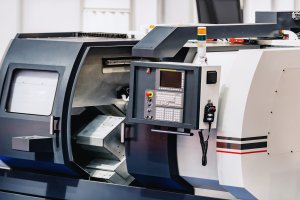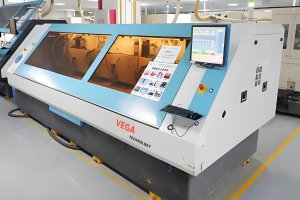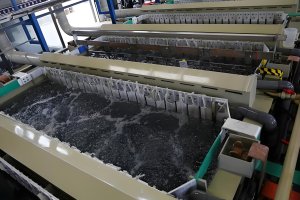Introduction to Precision CNC Machining for Food Machinery
Precision CNC machining stands as a cornerstone in modern manufacturing, offering unparalleled accuracy and repeatability essential for the food machinery sector. In this industry, the machinery must not only operate to exact specifications but also meet rigorous safety and hygiene standards. Protective coatings play a pivotal role in this context, enhancing machinery’s durability and compliance with stringent food safety regulations.
The application of CNC technology in food machinery includes the fabrication of complex components such as mixers, slicers, and packaging machines. These components require surfaces that can withstand frequent exposure to corrosive cleaning agents and varying temperatures without degrading. Thus, the choice of appropriate coatings is critical, as it directly impacts the machinery’s longevity and safety in food processing environments.
What are the Common Challenges in Coating Food Machinery?
The implementation of coatings on food machinery presents several challenges:
- Corrosion Resistance: Food processing environments are harsh, with high exposure to water, salts, and acids, which can lead to rapid corrosion of metal components.
- Compliance with Regulations: All materials used must comply with FDA regulations for food contact, demanding coatings that are non-toxic and prevent leaching of chemicals.
- Mechanical Wear and Thermal Stresses: Equipment must endure physical and thermal stresses without the coating cracking or peeling off.
Each of these challenges requires manufacturers to carefully consider the type of coatings used, balancing performance with regulatory compliance. For instance, the use of polytetrafluoroethylene (PTFE) coatings, commonly known as Teflon, is prevalent due to its non-reactive nature and ability to withstand high temperatures, making it ideal for food machinery.
How Do Coating Materials Impact Machine Efficiency and Safety?
Selecting the right coating materials is crucial for ensuring machine efficiency and safety. Different materials offer varying degrees of protection against wear, corrosion, and contamination. For example:
- Teflon (PTFE): Offers excellent non-stick properties and thermal resistance, ideal for heat-intensive food processing.
- Epoxy Coatings: Provide strong chemical and corrosion resistance, suitable for acidic or basic environments.
Case Study: A bakery installed new ovens with a ceramic coating designed to handle high temperatures and resist food residues. Over six months, the ovens operated with significantly reduced cleaning times and decreased energy consumption, demonstrating the effectiveness of selecting the right coating for specific needs.
Data Table: Comparison of Coating Materials
| Material | Durability | Safety Standard Compliance | Cost-effectiveness |
|---|---|---|---|
| Teflon (PTFE) | High | FDA Approved | Moderate |
| Epoxy | Moderate | FDA Approved | Low |
| Ceramic | Very High | FDA Approved | High |
| Silicone | Low | FDA Approved | Low |
| Stainless Steel | Moderate | FDA Approved | Moderate |
| Polyurethane | High | FDA Approved | Moderate |
| Nickel | High | Limited Approval | High |
This data table provides an overview of how each coating type ranks in terms of durability, compliance with safety standards, and cost-effectiveness, offering tangible insights into the decision-making process for coating food machinery.
Technological Innovations in Coating Application Techniques
The application of coatings has been revolutionized by technological advancements, making the process more efficient and effective. Techniques such as electrostatic spraying and plasma treatments have become popular due to their ability to evenly coat complex surfaces and enhance adhesion.
Electrostatic Spraying: This technique uses charged particles to ensure that the coating uniformly covers the surface, including hard-to-reach areas, which is crucial for intricate machinery components used in food processing.
Plasma Coating: Involves using plasma to clean and activate the surface before applying a coating, significantly improving adhesion and longevity.
Data Table: Analysis of Coating Application Techniques
| Technique | Cost | Efficiency | Uniformity | Durability |
|---|---|---|---|---|
| Electrostatic Spray | High | Very High | Excellent | High |
| Dip Coating | Low | Moderate | Good | Moderate |
| Plasma Coating | High | High | Excellent | Very High |
| Manual Brushing | Low | Low | Poor | Low |
| Automated Spraying | Moderate | High | Very Good | High |
These innovative methods not only ensure better coating performance but also contribute to longer machinery life and reduced maintenance costs.
Why Is Material Compatibility Important in Selecting Coatings?
The compatibility of coating materials with the substrates they protect is crucial for ensuring the longevity and safety of food machinery. Incompatible materials can lead to chemical reactions that degrade the coating or the underlying surface, potentially contaminating food products and causing machinery failure.
Case Study: A dairy processor experienced frequent equipment failures until they switched to a silicone-based coating compatible with their stainless steel machinery. This change resulted in a dramatic reduction in corrosion and maintenance costs.
Data Table: Material Compatibility and Coating Performance
| Substrate Material | Compatible Coatings | Properties | Compatibility Score |
|---|---|---|---|
| Stainless Steel | Silicone, Epoxy | Non-reactive, Durable | High |
| Aluminum | Polyurethane, Ceramic | Lightweight, Corrosion-resistant | High |
| Plastic | Acrylic, Polyurethane | Flexible, Economical | Moderate |
| Copper | Nickel, Epoxy | Conductive, Requires extra protection | Moderate |
Understanding these interactions helps in selecting the most effective coatings that ensure safety and efficiency.
Maintaining Coated Machinery: Best Practices and Procedures
Proper maintenance is key to maximizing the performance and extending the lifespan of coated machinery. Regular maintenance routines not only preserve the coating’s integrity but also ensure that machinery operates at optimal efficiency.
Best Practices for Maintenance:
- Regular cleaning with appropriate cleaning agents that do not degrade the coating.
- Scheduled inspections to detect early signs of wear or damage.
- Immediate repairs to damaged coatings to prevent further deterioration.
Case Study: A meat processing plant implemented a routine maintenance schedule for their coated grinders and saws. This program included monthly inspections and bi-annual recoatings, resulting in a 50% reduction in equipment downtime and a 30% decrease in repair costs over two years.
Continued maintenance not only ensures operational efficiency but also maintains compliance with health and safety regulations, crucial for the food processing industry.
Future Trends in Coatings for Food Industry CNC Machines
Emerging technologies and materials promise to further enhance the functionality of coatings in the food industry. Innovations such as nanotechnology are being explored for their potential to create ultra-thin, highly durable coatings that are both effective and economical.
Predictive Analytics: The use of data analytics to predict when coatings will fail and require replacement is becoming more common, allowing for proactive maintenance that minimizes downtime.
Smart Coatings: These coatings change color or texture in response to environmental changes, providing real-time alerts to potential issues such as overheating or chemical exposure.
Data Table: Future Coating Technologies
| Technology | Potential Impact | Current Development Stage |
|---|---|---|
| Nanocoatings | Increase durability, reduce material use | Research & Development |
| Bio-based Coatings | Improve sustainability, reduce toxicity | Early Commercial Use |
| Smart Coatings | Real-time monitoring, enhance safety | Prototype Testing |
These advancements are setting the stage for a new era in coating technology, focusing on sustainability, efficiency, and enhanced performance.
Other Articles You Might Enjoy
- Elevating Precision Standards through Chamfer in CNC Machining
1. Introduction: The Pursuit of Unparalleled Precision In the realm of CNC machining, precision is paramount. This section introduces the article by exploring the significance of precision in manufacturing and…
- Precision Prowess: Unveiling the Advantages of China CNC Machining
1. Introduction: The Role of Precision in Manufacturing Excellence In this introductory section, we delve into the critical role that precision plays in manufacturing and set the stage for an…
- Revolutionizing CNC Machining for Complex Aerospace Assemblies
Introduction to CNC Machining in Aerospace Assemblies Computer Numerical Control (CNC) machining represents a significant technological development playing a notable role in the creation of complex aerospace assemblies. CNC machining…






